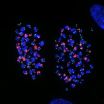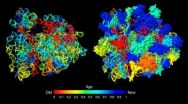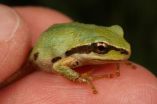At the ongoing Genetics Society of America's 53rd Annual Drosophila Research Conference in Chicago, several scientific investigators shared their knowledge of some of these diseases, including ataxia-telangiectasia (A-T), a neurodegenerative disorder; Rett Syndrome, a neurodevelopmental disorder; and kidney stones, a common health ailment. All are the subject on ongoing research using the Drosophila model system.
Andrew Petersen, a graduate student in Dr. David Wassarman's laboratory at the University of Wisconsin-Madison, discussed his experiments with a fly model of the rare childhood disease ataxia-telangiectasia. A-T causes cell death within the brain, poor coordination, characteristic spidery blood vessels that show through the skin, and susceptibility to leukemias and lymphomas. A-T generally results in a life expectancy of only 25 years.
A-T is normally lethal in flies, but Mr. Petersen induced a mutant that develops symptoms only when the environmental temperature rises above a certain level, allowing Mr. Petersen to control the lethality by varying the fly's environment. The mutant flies lose their ability to climb up the sides of their vial habitats –- a sign of neurodegeneration -- and die prematurely. Their glial cells are primarily affected, rather than the neurons that the glia support. In addition, an innate immune response is activated in the compromised glia, a scenario reminiscent of Alzheimer's and Parkinson's diseases. "We are one step closer to knowing how these diseases occur and possibly how we can treat them," Mr. Petersen concluded.
Sarah Certel, Ph.D., assistant professor of biological sciences at the University of Montana-Missoula, works with flies that have been altered to include the human gene MeCP2. This gene controls how neurons use many other genes, and the amount of the protein that it encodes must be within a specific range for the brain to develop normally. Too little of the protein and Rett syndrome results, a disorder on the X chromosome, which exclusively affects females in childhood. (Males with this mutation are generally miscarried or are stillborn.) It causes a constellation of symptoms including characteristic hand-wringing, autism, seizures, cognitive impairment, and loss of mobility. Yet too much of the protein causes similar problems.
In flies, altered levels of the MeCP2 protein affect sleep and aggression. For flies and most model organisms, sleep is inferred as the absence of activity during the day and night. To study sleep, Dr. Certel conducted "actograms" for individual flies. "The actogram records the activities of individually housed flies when they cross an infrared beam," she explained. The flies' sleep became fragmented, delayed, and shortened. "We're studying the link between the cellular changes and behaviors," she added.
Switching from the brain to the urinary system, it was noted that "Drosophila get kidney stones too" began Julian Dow, Ph.D., professor of molecular and integrative physiology at the University of Glasgow, United Kingdom. The fly version of a kidney is much simpler in design, a quartet of Malpighian tubules that are conveniently transparent.
Dr. Dow discussed a fly mutant called "rosy," discovered a century ago, that corresponds to the rare human inborn error of metabolism called xanthinuria type 1, as well as a diet-induced blockage that corresponds to the more common human condition of calcium oxalate kidney stones. In time-lapse video, Dr. Dow showed stones appearing and growing in the Malpighian tubule.
"This was the first time in history that we saw kidney stones form -- something that you cannot ethically do in humans," he said. His research group, in collaboration with Dr. Michael Romero at the Mayo Institute, is now searching for chemical compounds that interfere with the formation of stones and their tendency to accrete into painful obstructions. They've already found a way to block a gene responsible for transporting the oxalate, slowing stone formation. With time, this work could help reduce the 250,000 emergency room admissions for kidney stones in the USA annually and the more than $2 billion in health care costs for treating them.
These were only three of several human diseases discussed at the Drosophila Conference. Others included oxidative stress, cancer linked to diabetes, amyloid build-up in Alzheimer's disease, epilepsy, and muscular dystrophy. There are so many human diseases that have Drosophila counterparts that they are listed in a database called Homophila. Given the number that exist, we are certain to be learning more about our health from the fly in the years ahead.
INFORMATION:
ABOUT THE GSA DROSOPHILA RESEARCH CONFERENCE: At least 1,500 researchers attend the annual GSA Drosophila Research Conference to share the latest research using the fruit fly Drosophila melanogaster and other insect species. Many of findings from these model organisms have broad application for the study of human genetic traits and diseases. For more information about the conference, see www.drosophila-conf.org/2012/.
ABOUT GSA: Founded in 1931, the Genetics Society of America (GSA) is the professional membership organization for scientific researchers, educators, bioengineers, bioinformaticians and others interested in the field of genetics. Its nearly 5,000 members work to advance knowledge in the basic mechanisms of inheritance, from the molecular to the population level. The GSA is dedicated to promoting research in genetics and to facilitating communication among geneticists worldwide through its conferences, including the biennial conference on Model Organisms to Human Biology, an interdisciplinary meeting on current and cutting edge topics in genetics research, as well as annual and biennial meetings that focus on the genetics of particular organisms, including C. elegans, Drosophila, fungi, mice, yeast, and zebrafish. GSA publishes GENETICS, a leading journal in the field and a new online, open-access publication, G3: Genes|Genomes|Genetics. For more information about GSA, please visit www.genetics-gsa.org. Also follow GSA on Facebook at facebook.com/GeneticsGSA and on Twitter @GeneticsGSA.
END



